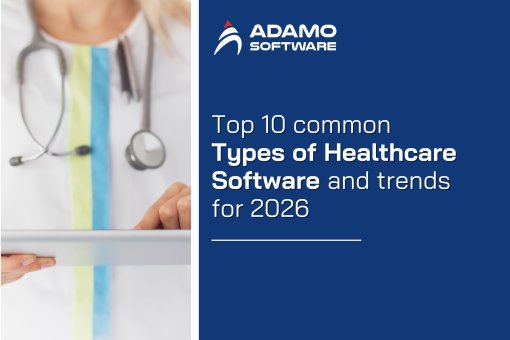Top 15+ advanced Fitness Tracker App Features to consider in 2025
People are paying more attention to their health, and thus, fitness tracker apps have become an essential and popular tool for monitoring health. These apps offer users a comprehensive way to approach healthcare, things they need to do to improve their health, nutritional diets they can follow, etc. By building personalized data, AI-powered analytics, and seamless integration with smart devices, these apps are changing how we care for ourselves. So, what are the features that a health and fitness app needs? Let Adamo Software discuss more detailed information about the advanced fitness tracker app features.
Through this blog post, you will learn the top 15 must-have fitness tracker app features and advanced features to take your fitness app to the next level. Besides, the APIs and technologies for fitness tracker apps and the future trends of developing a fitness tracker app. All information has been thoroughly researched and updated to the latest trends. So, let’s read our post and find yourself some useful pieces of information!
I. Top 15 Must-have fitness tracker app features
To provide the best user experience, fitness tracker apps must have enough features so that users can easily use, follow the information in the app, and reach their decided goals in improving their health. Below are the top 15 must-have fitness tracker app features that you may consider when developing your app.
![]()
1. Sign up and login
All apps need sign-up and login features. So does the fitness tracker app. Only when you successfully register and log in to your account can you use the app. This makes it become one of the indispensable fitness tracker app features.
With sign-up and login features, users can create personal accounts, store and secure their health data, and access the app’s services and features.
- Sign-up
Users must provide basic information such as name, email, password, and possibly initial health data such as age, gender, weight, and height. Some apps may require confirmation via email or phone number to ensure security. Once registered, users will gain access to a personalized account where they can monitor their health progress and fitness objectives.
- Login
After signing up, users can use their registered email to log in to their account. Or they can log in with Google or Facebook. This seamless approach allows for quick and easy access to the application.
2. Personalized workout goals
Wanna enhance the user experience for your app? So, you will need to integrate the personalized workout goals feature. This is one of the most popular fitness tracker app features. This feature operates when users input their age, gender, height, weight, and current activity level into your app. This helps assess fitness and set goals, such as losing weight, gaining muscle, improving endurance or general health.
Besides, users can adjust goals or follow app recommendations. Each time they complete a goal; the app will automatically change to the next goals and exercises. Simultaneously, the app also provides tools to evaluate and track progress, helping to motivate and maintain commitment to the plan. This personalization optimizes workout efficiency and turns the app into a comprehensive health coach. Thanks to this, it has become one of the indispensable fitness tracker app features that help to enhance user experience.
3. Real-time updating
Real-time updating is also among the important fitness tracker app features that you may integrate into your app. This helps users monitor and manage health activities accurately and instantly. When developing your app, you must consider using modern sensor technology from smart wearable devices to collect data such as heart rate, calories burned, distance traveled, or sleep status. These pieces of information will then be processed and displayed on users’ applications. Thanks to this, users can know their training progress or current health status.
In addition, the real-time updating also alerts users of abnormalities. The app can alert users to potential health concerns, such as unusually high or low heart rates during exercise and provide timely advice to keep them on track. Overall, real-time updates improve user experience and optimize training.
4. Multi-platform approach
Multi-platform approach is among the fitness tracker app features that boost user engagement to your app. It allows users to use the fitness tracker apps on different devices and operating systems, bringing maximum flexibility and convenience. Let’s design your app for multiple devices like phones, tablets, smartwatches, and computers.
Health data syncs across devices. The app’s integration with popular health platforms like Google Fit and Apple Health further streamlines users’ health journey. Thanks to the multi-platform approach ability, users can optimize their experience and maintain continuous health monitoring and management in all daily activities.
5. Offline mode
Offline mode is also one of the fitness tracker app features that you must focus on. This feature allows users to use the app and check some information even when there is no Internet connection. Instead of depending on the Internet connection. You should create offline access and create backups.
With this convenient feature, users can capture their activity data (steps, heart rate, distance, and workouts) directly on the device, even when offline. Once connected to the internet, the data seamlessly syncs to the cloud, providing a complete and uninterrupted record of their fitness journey. Overall, offline access provides convenience, ensuring a seamless experience that is independent of network connection.
6. Measuring health indicators
Tracking heart rate, calories, blood pressure, diet, etc., helps measure progress and monitor vital signs. This is one of the essential fitness tracker app features that provides comprehensive information on users’ fitness levels. The app tracks heart rate, SpO2, blood pressure, calories, breathing, and sleep. Data is displayed in charts and reports.
7. Push notifications
The push notifications feature is one of the effective fitness tracker app features, helping the app connect and continuously interact with users. This feature provides reminders and information to support healthy habits and fitness goals.
The app sends reminders for exercise, hydration, rest, and meal tracking. In addition, important health alerts, such as irregular heart rate or the need to increase physical activity, are also communicated on time so that users can adjust their plans accordingly. Overall, push notifications are among the best fitness tracker app features that help to increase user engagement and build a continuous and effective healthcare experience.
8. AI integration and data analysis
By incorporating AI, fitness tracker apps can collect and analyze vast amounts of user data, including physical activity levels, health metrics, dietary habits, and sleep patterns. This advanced data analysis enables the app to provide personalized insights and recommendations tailored to everyone’s needs.
AI analyzes user behavior for lifestyle recommendations and identifies potential health risks like heart disease, and diabetes. Some improvements include increasing physical activity, adjusting diet, or improving sleep.
9. Customized meal plans
Customized meal plans feature is among the useful fitness tracker app features you should integrate into your app. It helps users design personalized meal plans. This feature optimizes workouts and supports long-term health.
- Analyzing nutritional needs
The app analyzes your age, gender, activity level, health status, and weight goals. Using these data, the app can calculate the ideal daily intake of calories, protein, fat, carbohydrates, and essential vitamins and minerals.
- Creating a custom menu
With this feature, users can customize menus based on preferences, allergies, or diets. The diets can be keto, vegan, or gluten-free diets.
- Tracking and adjusting
Users can log meals eaten and track calories consumed throughout the day. The app will then give warnings when they exceed or fall short of their nutritional goals. Based on their progress toward their goals, the app can adjust the menu for the following days to accommodate changing needs and goals.
10. Integration with social media networks
The integration with social media networks is among the best fitness tracker app features. It helps your fitness apps create an active and engaged community of users. With this feature, users can share their achievements, challenges, and workout progress on social media platforms such as Facebook, Instagram, X, etc.
- Share achievements
Users can easily share their daily workout results, steps, distance, or calories burned on social media to show off their achievements to friends, family, and the community. This helps motivate and encourage others to participate in physical activity.
- Participating in challenges and group events
Apps can organize workout challenges or group events where users can invite friends to join, compare results, and compete. This creates interaction and encourages better achievement of health goals.
11. Gamification
Gamification is one of the most exciting fitness tracker app features. This turns users’ exercise and self-care progress into a fun, engaging experience. By applying game elements to everyday activities, this feature helps maintain motivation and encourages users to work towards and complete their health goals.
For example, users can receive reward points when they complete exercise goals such as walking a certain number of steps, burning a certain number of calories, or participating in challenges. The reward points can be used to level up, unlock new features, or redeem gifts, creating excitement and long-term engagement.
12. Monitoring mental health
Among the fitness tracker app features, monitoring mental health is also an important feature. It helps users pay attention to their emotional and mental state along with their physical condition. This feature helps users identify, evaluate, and improve their mental health, thereby building a more balanced and happier lifestyle.
The application allows users to record their emotions through questionnaires, stress scales, or emotional diary notes. This data will help users track their moods over time and identify factors that affect their mental health. Besides, the app may also recommend users deep breathing exercises, meditation, yoga, or listening to relaxing music to reduce stress and improve concentration. These exercises can be customized according to the user’s needs and time.
13. Integration with healthcare services
Integration with healthcare services is one of the notable fitness tracker app features. This helps health-tracking apps connect users with medical resources and professional support. Besides enhancing the personalized experience, this feature ensures that users receive timely advice and care when needed. Here’s how this feature helps.
- Connecting users with healthcare facilities
- Sharing medical and health data
- Telehealth
- Pharmacy suggestions and online medicine purchase
- Monitoring treatment plan
Overall, the integration with healthcare services not only enhances the efficiency of personal health management but also facilitates users to access healthcare services easily, seamlessly, and reliably.
14. Advanced data security
Advanced data security is among the must-have fitness tracker app features, ensuring users’ personal information and sensitive health data. With large volumes of data and high levels of personalization, protecting information not only builds trust but also complies with legal standards for security. This feature involves data encryption, two-factor authentication (2FA), access management, regulatory compliance, security breach notification, and secure cloud storage.
15. Multi-language and regional support
Multi-language and regional support are also outstanding fitness tracker app features, making a health-tracking app accessible and relevant to global users. This feature improves personalized experience and expands the market for the app, making it convenient for users in different geographies and cultures.
The application allows users to choose the interface language, from popular languages such as English, Chinese, and Spanish, to local languages. This makes it easy for users to understand and use the features without language barriers. For paid services, the app supports popular payment methods in each country, such as e-wallets, bank transfers, or international payment gateways.
II. Advanced features to take your fitness app to the next level
Beyond the above fitness tracker app features, your app must integrate advanced features to compete in the fitness app market. These features not only meet the growing needs of users but also enhance personalization, efficiency, and engagement. Let’s find some outstanding advanced fitness tracker app features with Adamo Software!
1. Virtual coach
A virtual coach can be one of the advanced fitness tracker app features that you need to design for your app. You can integrate augmented reality (AR) or artificial intelligence to provide personalized workout guidance for your users so that they can do exercise right at home. Thanks to this feature, users can perform exercises with the right technique without having to go to the gym or hire a personal trainer. Here’s how a virtual coach can help you.
- Detailed exercise instructions using Illustrative videos and AR technology
- Instant analysis and feedback
- Customizing users’ workouts
- Integrating training motivation
- Tracking results and suggesting improvements
In general, the virtual coach feature helps users save costs and time and improves training efficiency, providing a professional, personalized, and exciting experience in their healthcare journey.
2. Geolocation
Geolocation is one of the most important and useful fitness tracker app features, especially for those who love outdoor training such as running, cycling, or climbing. This feature helps users track and record their journey and also provides supporting information during the training process.
The app uses GPS to record the user’s route during outdoor activities such as running, walking, cycling, or climbing. This helps users clearly see the distance traveled, speed, and time of each workout. Besides, this feature of the app can suggest new workout routes based on the user’s current location or based on their interests and fitness level. The app can provide detailed maps of parks, running areas, or outdoor sports venues.
Additionally, geolocation helps ensure the safety of users when exercising outdoors. If a user encounters an accident or stops for a long time in an unusual location, the app can send a warning message to relatives or emergency support services. Overall, geolocation not only helps users track their workouts but also enhances the outdoor sports experience, providing motivation and safety when exploring new routes.
3. Integrated smart sleep plan
The integrated smart sleep plan feature is one of the advanced fitness tracker app features that can help users optimize their overall health, especially for those who want to improve their sleep quality. A good night’s sleep is not only important for physical health but also has a great impact on mental health and exercise performance.
The app uses sensors from a wearable device or smartphone to track sleep stages such as light sleep, deep sleep, and REM (Rapid Eye Movement). Based on this data, the app can provide a detailed report on the user’s sleep quality. Besides, this feature can analyze a user’s sleep habits and make recommendations for an appropriate bedtime based on factors such as daily activity levels, health goals, and rest needs.
The app can set reminders to let users know when to go to bed to get the most restorative, restorative sleep. This feature is especially useful for people with busy schedules or who don’t have a consistent bedtime routine.
III. APIs and Technologies for fitness tracker apps
If you want your app to have comprehensive fitness tracker app features to enhance user experience, you must use advanced APIs and technologies. Let’s find some popular tools and solutions for fitness tracker apps.
1. APIs for health data collection and synchronization
In the development of fitness tracker app features, the ability to collect and analyze data is the core factor helping your app operate effectively and provide accurate information for users. Integrating the right APIs will help connect devices and data sources seamlessly, delivering superior experiences. Below are some outstanding APIs.
- Google Fit API
Google Fit API is one of the most commonly used APIs that add various capabilities to a fitness tracker app. This API supports collecting data from Android devices and third-party applications. With this API, your app can monitor metrics like steps, distance traveled, calories burned, and sleep quality, and store the information in Google Fit Cloud. Although this API provides a powerful and diverse ecosystem for tracking a wide variety of health data, its features may be limited when used on non-Android devices.
- Apple HealthKit
Apple HealthKit is also among the APIs you should consider making the best of the fitness tracker app features. This API is designed to synchronize data from iPhone, Apple Watch, and related devices. It supports tracking metrics such as heart rate, sleep, physical activity, and hydration levels, providing an optimal experience for users across the Apple ecosystem.
Besides a diverse source of data, this API has high security thanks to compliance with Apple’s own standards for privacy and data protection. However, when you use this API to develop your fitness tracker app features, it may take time due to Apple’s strict regulations.
- Fitbit Web API
This API connects user apps to data from Fitbit devices, allowing them to track heart rate, calories burned, steps, sleep, and even specific workouts. The Fitbit Web API also provides access to a user’s activity history for further analysis. This API has a good data analytics system, which makes it easy to generate in-depth reports. However, the functions will be limited if there is no Fitbit device, reducing app flexibility. Higher usage and integration costs compared to some other APIs. Besides, it has higher usage and integration costs compared to some other APIs.
In addition to the above APIs, you can also consider using Garmin Health API, Polar Open AccessLink, WHOOP API, etc., to develop your fitness tracker app features. The choice of API depends on the application’s goals and the specific needs of the users. So, you need to consider the pros and cons to integrate most effectively.
2. Popular technologies to develop fitness tracker app features
To develop advanced fitness tracker app features that meet the needs of modern users, choosing the right technologies is key. These technologies not only support accurate data tracking but also ensure a smooth, secure, and highly customizable experience. Here are some popular technologies.
- Advanced data analytics
Advanced data analytics are among the technologies that can help you develop your fitness tracker app features. You can use machine learning to analyze user health and behavior data to personalize workout and nutrition plans. TensorFlow and PyTorch are popular platforms for this purpose.
Besides machine learning, big data analytics is also helpful. Let’s apply big data analytics solutions such as Apache Hadoop or Spark to process and gain deeper insights into user health data.
- Location and mapping technology
Location and mapping technology is also a helpful tool to have your fitness tracker app features developed. Google maps APIs support location and provide maps for outdoor activities such as running or cycling. This feature helps create optimal routes and record user journeys. Besides, Mapbox is also another option for integrating maps with the ability to customize the interface and support accurate GPS tracking.
- AI and virtual assistant integration
As mentioned, the ability to integrate with AI is one of the outstanding fitness tracker app features. Thus, AI and virtual assistant integration technology becomes essential tools. Let’s integrate National Language Processing to develop virtual assistants such as chatbots or voice assistants, supporting answering questions, planning workouts, or reminding users.
In general, by combining the above APIs and technologies, you can develop your fitness tracker app features. Besides, you can optimize user experience, while ensuring security and efficiency in health data management.
IV. Future trends in fitness tracker app development
In the future, your healthcare app can become smarter and personalized with more advanced fitness tracker app features. This is thanks to the advancements in technology. Here are some of the prominent trends that are expected to shape the future of this field.
![]()
1. Machine learning
As mentioned above, machine learning is among the popular technologies that can help you build your fitness tracker app features. This will become a trend in the future, helping your app better understand users’ individual behaviors and needs. Features like automated workout recommendations or workout performance analysis will become more common.
2. Integrating virtual reality (VR) and augmented reality (AR)
VR and AR will make boring workouts more interesting by creating realistic training experiences, such as participating in a virtual running environment or doing yoga with 3D guided images.
This technology also supports virtual classes, expanding unique fitness tracker app features, increasing interactivity and excitement.
3. Enhanced comprehensive healthcare features
Fitness tracker apps not only focus on physical training but also integrate many features about mental health, sleep, and nutrition.
Workout plans will combine with diet and sleep quality monitoring to provide optimal suggestions, expanding the range of fitness tracker app features.
4. Deeper personalization with big data and behavioral analytics
Using Big Data will help fitness tracker app features deeper personalization based on each user’s behavioral data.
Optimized recommendations such as workouts, sleep habits, or nutrition plans will create a more unique and engaging experience.
In general, fitness tracker apps will not only be a simple health tracking tool but also a comprehensive solution in personalized health care. These trends promise to shape a generation of smarter and more advanced fitness tracker apps.
Read more: Top 15 Fitness Tracker App Android to keep you healthy
V. Let’s build your fitness tracker app with Adamo Software

Do you want to build a fitness tracker app but haven’t known how to deploy and start building? If yes, let’s work with Adamo Software to have your ideas implemented. As one of Vietnam’s leading technology companies, we can help you build your fitness tracker app. With a series of successful projects in the healthcare and technology fields, our team has the skills and knowledge to build outstanding features such as heart rate monitoring, step counting, and sleep analysis. Here’s how Adamo can help you.
- Consulting strategy and ideation
Adamo’s team of experts will work with you to analyze the market, identify user needs, and propose suitable features. From choosing the necessary fitness tracker app features such as heart rate, steps, sleep tracking, to social media integration and AI, we ensure your app meets the right needs.
- Develop a comprehensive technology solution
We will use advanced technologies to help you build your app. These technologies include AI and machine learning, sensor technology, big data, etc.
- Focusing on UX/ UI
A fitness tracker app not only needs to be strong in features but also intuitive and easy to use. Adamo will design a friendly interface, optimizing the user experience to ensure that all features from health tracking to achievement sharing are easy to operate.
- Ensure security and compliance
Data security is an indispensable factor in any health application. We ensure that all data will be encrypted and stored securely. Besides, we also comply with encrypted and stored securely.
- Post-deployment support
Beyond handling over product, we also provide maintenance, upgrade and technical support services after the application is launched. We are always ready to work with you to improve and expand the fitness tracker app features to better meet the needs of users.
Still hesitating whether to choose Adamo as your partner? Let’s contact us for more detailed information!











